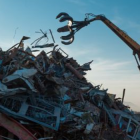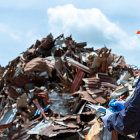The global scrap market is a multi-billion-dollar industry, with demand for recycled materials rising across the globe. Metals like aluminium, copper, and steel are in constant circulation, moving through supply chains and being repurposed for new products. In this blog, we will explore the current trends, key challenges, and exciting opportunities in the global scrap market.
Global Scrap Market Overview
The scrap market operates as a critical part of the global recycling system, ensuring that materials can be reused in production instead of being discarded. Key sectors involved include:
- Metal Scrap (steel, aluminium, copper)
- Electronic Scrap (circuit boards, appliances)
- Plastic and Rubber Scrap (plastics from packaging, automotive, etc.)
The growing focus on sustainability has increased the demand for recycled materials, and many countries have enacted strict environmental regulations that encourage scrap recycling. Additionally, the rise of circular economy practices is changing how businesses and industries view scrap.
Key Trends Shaping the Global Scrap Market
- Increased Demand for Sustainable Practices: Governments worldwide are implementing stricter waste management regulations, leading to a rise in the demand for scrap recycling. Companies are being incentivized to use recycled materials to minimize environmental impact.
- Technology in Scrap Sorting and Processing: The use of advanced sorting and processing technologies, such as AI-driven recycling centers, has increased efficiency in identifying and processing valuable scrap materials.
- International Trade and Market Fluctuations: The scrap market is highly sensitive to international trade policies. For example, changes in tariffs on scrap exports between countries like China and the U.S. have significant impacts on global prices and supply chains.
Challenges in the Scrap Industry
Despite the positive trends, the industry still faces several challenges:
- Quality Control: The contamination of scrap materials with non-recyclable waste makes it harder for businesses to maintain high-quality standards.
- Supply Chain Disruptions: Geopolitical events, trade wars, and transportation issues can disrupt the movement of scrap materials across borders.
- Regulatory Compliance: Compliance with international and local regulations can be complex, especially as environmental laws become more stringent.
Opportunities for Growth in the Scrap Market
- Emerging Markets: Countries in Asia and Africa are becoming key players in the scrap market, with growing demand for raw materials due to rapid urbanization.
- Innovation in Recycling Technologies: Investment in automated sorting, smart tracking systems, and blockchain technology can help businesses overcome current challenges and improve the efficiency of their recycling processes.
Conclusion
The global scrap market continues to evolve, offering exciting opportunities for businesses to grow while contributing to a sustainable future. As technologies improve and regulatory pressures increase, the scrap market will remain a key player in the transition to a circular economy.






